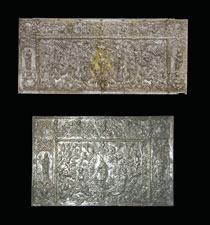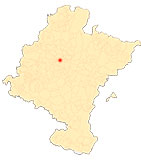Treasure of San Fermín
By Ignacio Miguéliz Valcarlos
Frontal and credence
The frontal and credence of San Fermín are the only Baroque-era example of this type in Navarre, similar pieces existing in other churches in Navarre having disappeared during the different conflicts and vicissitudes of the 19th century. The frontal was used to ornamentally cover the front of the altar table, while the credence had the same purpose but on the console or small altar where the Saint's jewels were placed.
The front, a rectangular panel, is articulated by a central body framed by a band, separated by a cordoned cord. The central body is covered with a variegated decoration of vegetal scrolls, floral buds and angels with the episcopal attributes, the mitre and the crosier, of invoice fleshy and fine execution, framing an oval medallion in the centre, supported by two mermaids and topped by a basket of flowers between cornucopias. Inscribed on the medallion is a relief of San Fermín in glory ascending to heaven. This image is very similar to the drawing of a water-bearer made by José de Yabar, the son of this craftsman, as an exam to gain access to Degree as a master silversmith in 1728. On the sides, on the outer band, there are two oval medallions with representations of Merit and award, in the manner of Virtues, symbols of the Saint's martyrdom and his reward. Completing the decoration of this border are the heraldic arms of Pamplona, the coat of arms with a lion passing through, crowned with a royal crown and bordered with chains, and the emblem of the five wounds, adopted by the Pamplona regiment in 1599. The credence follows the same model, in smaller dimensions, and with slight variations, such as the repertoire of plant motifs or the non-use of gilded silver, as well as less fleshiness in the plant elements and a less loose invoice .
The first of these works was commissioned by the Pamplona regiment from the silversmith Hernando de Yabar in 1724-1725. Subsequently, the City Council decided to commission two more pediments and a credence, setting as a condition that it should follow the model of the piece made by Yabar. The first two were commissioned in 1729 from Antonio Ripando, while the second was delivered by Juan Antonio Hernández in 1733.
However, due to the vicissitudes of time, of the four works commissioned by the City Council for the chapel of the Saint, only two have survived to the present day, a frontal and the credence. Probably, as Dr. Orbe Sivatte points out, the remodelling of the chapel of San Fermín at the beginning of the 19th century, which involved the removal of the side altarpieces, meant that the two frontispieces that were placed on them fell into disuse and were discarded by the chapel's workmen. In the case of the frontal, the fact that they all obeyed design made by Hernando de Yabar, and that chronologically they are very close in time, makes it impossible to attribute them to one of the two silversmiths who had made them, and it is possible to think that the piece preserved is the first to be made, the work of Hernando Yabar, which served as model for the other two. While we know the authorship of the credence thanks to the marks stamped on its surface, the locality, the double crowned PP corresponding to Pamplona, and the author, a venera, stamped by the silversmith Juan Antonio Hernández, the authorship of which is confirmed by the documentation.
-
ANDUEZA UNANUA, P., La arquitectura señorial de Pamplona en el siglo XVIII. Familia, urbanismo y ciudad, Pamplona, Government of Navarre, 2004.
-
ARBETETA MIRA, L., "Cadena y cruz pectoral del tesoro de San Fermín", in ARRAIZA FRAUCA, J., San Fermín patrono, Pamplona, Pamplona City Council, 1989.
-
ARRAIZA FRAUCA, J., San Fermín. El santo, la devoción, la fiesta, Pamplona, Pamplona City Council, 2002.
-
GARCÍA GAINZA, M. C., and others, Catalog Monumental de Navarra. V***. Merindad de Pamplona, Pamplona, Government of Navarre-Archbishopric of Pamplona-University of Navarre, 1997.
-
HEREDIA MORENO, M.C., "Ejemplos de mecenazgo indiano en la capilla de San Fermín de Pamplona", in yearbook de programs of study Americanos, Tomo XLVI, 1989.
-
HEREDIA MORENO, M.C., "Bandejas y jarras del tesoro de San Fermín", in GARCÍA GAINZA, M.C., and FERNÁNDEZ GRACIA, R., (coords.), Juan de Goyeneche y el triunfo de los navarros en la monarquía hispánica del siglo XVIII, Pamplona, Fundación Caja Navarra, 2005.
-
HEREDIA MORENO, M. C., ORBE SIVATTE, M., and ORBE SIVATTE, A., Arte hispanoamericano en Navarra. Plata, pintura y escultura, Pamplona, Government of Navarre, 1992.
-
MIGUÉLIZ VALCARLOS, I., "El tesoro de San Fermín: Donación de alhajas al Santo a lo largo del siglo XVIII", in Promoción y Mecenazgo del Arte en Navarra. Cuadernos de la Chair de Patrimonio y Arte Navarro, nº 2, Pamplona, Chair de Patrimonio y Arte Navarro, 2007.
-
MIGUÉLIZ VALCARLOS, I., "Sacras con los patronos de Navarra y Pamplona", in FERNÁNDEZ GRACIA, R. (coord.), Pamplona y San Cernín 1611-2011. IV Centenary of the city's vow, Pamplona, 2011.
-
MOLINS MUGUETA, J.L., Capilla de San Fermín en la iglesia de San Lorenzo de Pamplona, Pamplona, Diputación Foral de Navarra, 1974.
-
MOLINS MUGUETA, J.L., "La mitra y báculo dieciochescos de San Fermín", in Diario de Navarra. Extraordinary of San Fermín, Pamplona, 1984.
-
MOLINS MUGUETA, J.L., "Mitra y báculo de San Fermín", in MORALES, A. J., Filipinas, puerta de Oriente: de Legazpi a Malaspina, Barcelona, SEACEX, 2003.
-
MOLINS MUGUETA, J.L., "Mitra y báculo del tesoro de San Fermín", in GARCÍA GAINZA, M. C., and FERNÁNDEZ GRACIA, R., (coords.), Juan de Goyeneche y el triunfo de los navarros en la monarquía hispánica del siglo XVIII, Pamplona, Fundación Caja Navarra, 2005.
-
ORBE SIVATTE, A., Platería del reino de Navarra en el siglo del Renacimiento, Pamplona, Government of Navarre, 2000.
-
ORBE SIVATTE, M., Platería en el taller de Pamplona en los siglos del barroco, Pamplona, Government of Navarre, 2008.












